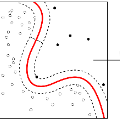Multi-view classification is inspired by the behavior of humans, especially when fine-grained features or in our case rarely occurring anomalies are to be detected. Current contributions point to the problem of how high-dimensional data can be fused. In this work, we build upon the deep support vector data description algorithm and address multi-perspective anomaly detection using three different fusion techniques i.e. early fusion, late fusion, and late fusion with multiple decoders. We employ different augmentation techniques with a denoising process to deal with scarce one-class data, which further improves the performance (ROC AUC = 80\%). Furthermore, we introduce the dices dataset that consists of over 2000 grayscale images of falling dices from multiple perspectives, with 5\% of the images containing rare anomalies (e.g. drill holes, sawing, or scratches). We evaluate our approach on the new dices dataset using images from two different perspectives and also benchmark on the standard MNIST dataset. Extensive experiments demonstrate that our proposed approach exceeds the state-of-the-art on both the MNIST and dices datasets. To the best of our knowledge, this is the first work that focuses on addressing multi-perspective anomaly detection in images by jointly using different perspectives together with one single objective function for anomaly detection.
翻译:多视角分类是由人类的行为启发的,特别是在细微的特性或我们很少发现异常现象的情况下,人类的行为会启发多视角分类,特别是在细微的特性或我们很少发现异常现象的情况下。目前的贡献表明如何将高维数据结合在一起的问题。在这项工作中,我们利用深度支持矢量数据描述算法,利用三种不同的聚合技术,即早期融合、延迟融合和与多个解密器的延迟融合,解决多视角异常现象的检测。我们使用不同的增强技术处理稀缺的单级数据,这种数据进一步提高了性能(RCUC=80 ⁇ )。此外,我们引入了骰子数据集,其中包括2000年以上从多个角度下降的骰子灰度图像,其中5 ⁇ 图像含有稀有的异常(例如钻孔、锯子或刮子)。我们利用两个不同视角的图像来评估我们关于新的骰子数据集的方法,并设定了标准 MNIST数据集的基准。广泛的实验表明,我们所提议的方法超出了我们第一次检测结果的状态(ROC ACUC=80 ⁇ )。此外,我们提出的数据数据集中的第一个是用一种对目标性探测结果的同步分析,而一个是用一种对结果进行的。




